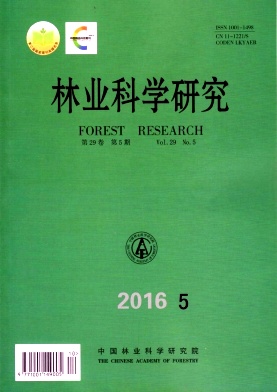|
[1]
|
Lee H J, Ravn M M, Coates R M. Synthesis and characterization of abietadiene, levopimaradiene, and neoabietadiene:hydrocarbon precuisors of the abietane diterpene resin acids[J]. Tetrahedron,2001,57(29):6155-6177. |
|
[2]
|
Manninen A M, Utriainen J, Holopainen T, et al. Comparing the variation of needle and wood terpenoids in Scots pine provenances[J].Can J For Res, 2002, 28(1):211-228. |
|
[3]
|
Lieutier F, Day K R, Battwasti A, et al. Bark and wood boring insects in living trees in Europe[J]. Dordrecht:Kluwer Academic Publishers, 2004:135-176,135-176. |
|
[4]
|
Tisdale R A, Nebeker T E, Hodger J D. The role of oleoresin flow in the induced response of loblolly pine to a southern pine beetle associated fungus[J]. Can J Bot, 2003,81(4):368-374. |
|
[5]
|
Roberds R H, Storm B L, Hain F P, et al. Estimates of genetic parameters for oleoresin and growth traits in juvenile loblolly pine[J]. Canadian Journal of Forest Research,2003,33(12):2496-2476. |
|
[6]
|
Strom B L, Goyer R A, Ingram Jr. L L, et al. Oleoresin charecteristics of progeny of lobolly pines that escaped attack by the southern pine beetle[J]. For Ecol Manage, 2002, 158(1-3):169-178. |
|
[7]
|
贾洪敏, 黄大庄, 曹逸霞, 等. 松脂单萜类物质与油松对红脂大小蠹抗性的关系[J]. 东北林业大学学报,2008,36(1):48-50.
|
|
[8]
|
赵振东, 李冬梅, 胡樨萼, 等. 抗松材线虫病马尾松种源化学成分与抗性机理研究(第Ⅱ报)[J]. 林产化学与工业,2001,21(1):56-60.
|
|
[9]
|
李彦杰, 姜景民, 栾启福. 湿地松家系产脂力、树脂密度和松节油含量的测定与遗传分析[J]. 北京林业大学学报,2012,34(4):48-51.
|
|
[10]
|
刘青华, 金国庆, 王晖, 等. 马尾松巢式交配子代产脂力、生长和木材密度遗传分析[J].林业科学研究, 2014,27(6):715-720.
|
|
[11]
|
张谦, 曾令海, 何波祥, 等. 马尾松自由授粉家系产脂力的年度变化及遗传分析[J]. 林业科学, 2013, 49(1):48-52.
|
|
[12]
|
古研, 赵振东, 毕良武, 等. 马尾松松节油标准样品的定值研究[J]. 生物质化学工程, 2011, 45(1):21-24.
|
|
[13]
|
王振洪, 商士斌, 宋湛谦, 等. 气相色谱用马尾松松香标准样品的研制[J]. 生物质化学工程, 2007, 41(6):1-5.
|
|
[14]
|
岳水林, 荣文琛. 马尾松种源松脂组分的地理变异[J]. 林业科学研究, 1994,7(4):431-435.
|
|
[15]
|
尹晓兵, 耿树香, 马惠芬,等. 思茅松松脂松节油群体的物理及化学特征[J]. 南京林业大学学报:自然科学版, 2005,29(5):80-84.
|
|
[16]
|
李彦杰, 栾启福, 沈丹玉, 等. 湿地松自由授粉家系松脂组分遗传变异研究[J]. 林业科学研究, 2012,25(6):773-779.
|
|
[17]
|
庄伟瑛, 张玉英, 范国荣, 等. 湿地松松脂中单萜类组分研究初报[J]. 江西农业大学学报, 2008, 30(3):480-498.
|
|
[18]
|
庄伟瑛, 欧阳道明, 范国荣, 等. 湿地松松脂中单萜类组分研究续报[J]. 江西农业大学学报, 2009, 31(3):388-392.
|
|
[19]
|
金国庆, 秦国峰, 刘伟宏, 等. 马尾松生长性状交配效应的遗传分析及杂交组合选择[J]. 林业科学, 2008, 44(6):28-33.
|
|
[20]
|
续九如. 林木数量遗传学[M]. 北京:高等教育出版社, 2006.
|
|
[21]
|
孔繁玲. 植物数量遗传学[M]. 北京:中国农业大学出版社,2006.
|
|
[22]
|
李力, 施季森, 曹汉洋, 等. 杉木两水平双列杂交亲本配合力分析[J]. 南京林业大学学报, 2000, 24(5):9-13.
|
|
[23]
|
Jantan I, Ahmad A S,Ahmad I A. Oleoresins of three Pinus species from Malaysian pine plantations[J]. Journal of Essentoal Oil Research,2002, 14(5), 327-332. |
|
[24]
|
Rezzi S, Bighelli A, Castola V, et al. Composition and chemical variability of the oleoresin of Pinus nigra ssp. laricio from Corsica[J]. Industrial Crops and Products, 2005,21(1):71-79. |
|
[25]
|
Sprague G F, Tatum L A. General and specific combining ability in single crosses of corn[J]. Journal of American Society of Agronomy, 1942, 34(4):923-932. |
|
[26]
|
周志春, 金国庆, 秦国锋, 等. 马尾松纸浆材重要经济性状配合力及杂种优势分析[J]. 林业科学, 2004, 40(4):52-57.
|
|
[27]
|
Karanikas C, Walker V, Scaltsoyiannes A, et al. High vs. low yielding oleoresin Pinus halepensis Mill. trees GC terpenoids profiling as diagnostic tool[J]. Ann For Sci, 2010, 67(4):412P1-412P8. |
|
[28]
|
张培杲, 吴贯明. 森林遗传学试验新技术[M]. 北京:中国林业出版社,1981.
|





 DownLoad:
DownLoad: